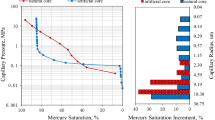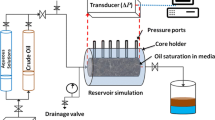Abstract
The equivalent alkane carbon number (EACN) of a crude oil, namely Ankleshwar crude, is successfully modeled by a mixture of pure alkanes. The EACN of the crude oil is found to be 9.3, and an appropriate mixture of nonane and decane exhibited phase behavior similar to that of the crude oil. A surfactant system for a water flooded reservoir at 80 C and having a salinity in the range of 2% to 3% NaCl is formulated by blending a phosphated ester with a petroleum sulfonate in the weight ratio of 2/5. The addition of phosphate ester not only increases the salt tolerance of the petroleum sulfonate system, it also broadens the IFT minimum. The oil displacement tests at 80 C in sandpacks and Berea cores showed that the surfactant formulation containing tertiary amyl alcohol (TAA) displaced 92% oil in sandpacks and 79% crude oil in Berea cores. The oil recovery efficiency was poor when formulations contained other alcohols. From the effluent surfactant concentration, it is shown that there is a correlation between the tertiary oil recovery, surfactant breakthrough and surfactant retention in porous media. It is proposed that, because alcohols such as isopropyl alcohol (IPA), isobutyl alcohol (IBA) and secondary butyl alcohol (SBA) partition significantly in the equilibrated excess brine phase, the alcohol-depleted surfactant slug forms stable emulsions resulting in faster breakthrough of surfactant in the effluent and lower oil displacement efficiency. In the case of TAA-containing formulation, there is a partitioning of TAA in the oil phase. Therefore, there is a mass transfer of alcohol from surfactant slug to the oil ganglia in porous media. This produces a transient ultralow IFT between residual oil and the surfactant solution which mobilizes oil, resulting in higher oil displacement efficiency.
Similar content being viewed by others
References
Salter, S.J., “Selection of Pseudo-Components in Surfactant-Oil-Brine-Alcohol Systems,” SPE 7056, paper presented at SPE Improved Oil Recovery Symposium, Tulsa, OK, April 1978.
Gogarty, W.B., “Micellar/Polymer Flooding—An Overview,” SPE 7041, paper presented at SPE Improved Oil Recovery Symposium, Tulsa, OK, April 1978.
Holm, L.W.,J. Pet. Tech., p. 1475, December, 1971.
Hill, H.J., J. Reisberg and G.L. Stegemeier,Ibid. February, p. 186 (1973).
Foster, W.R.,Ibid., p. 205, February, 1973.
Bae, J.H., “A Comparative Evaluation of Microemulsions and Aqueous Surfactant Systems,” SPE 4749, paper presented at SPE Improved Oil Recovery Symposium, Tulsa, OK, April 1974.
Reed, R.L., and R.N. Healy, inImproved Oil Recovery by Surfactant and Polymer Flooding, edited by D.O. Shah and R.S. Schecter, Academic Press, NY, 1977, p. 383.
Shah, D.O., “Fundamental Aspects of Surfactant-Polymer Flooding Process,” Second European Symposium on Enhanced Oil Recovery, Bournemouth, England, September 1981.
Healy, R.N., and R.L. Reed,Soc. Pet. Eng. J., p. 129, April 1977.
Novosad, J.,Ibid., p. 962, December 1982.
Novosad, J., B. Maini and J. Batycky,J. Am. Oil Chem. Soc. 59:833A (1982).
Glover, C.J., M.C. Puerto, J.M. Maerker and E.L. Sandvik, “Surfactant Phase Behavior and Retention in Porous Media,” SPE 7053, paper presented at SPE Symposium on Improved Oil Recovery, Tulsa, OK, April 1978.
Bae, J.H., C.B. Petrick and R. Ehrlich, “A Comparative Evaluation of Microemulsions and Aqueous Surfactant Systems,” SPE 4749, paper presented at SPE Symposium on Improved Oil Recovery, Tulsa, OK April 1974.
Poettman, F.H., and W.R. Hause, “Micellar-Polymer Screening Criteria and Design,” SPE 7068, paper presented at SPE Symposium on Improved Oil Recovery, Tulsa, OK, April 1978.
Rathmell, J.J., F.W. Smith, S.I. Salter and T.R. Fink, “Evaluation of Optimal Salinity Concept for Design of a High Water Content Micellar Flood,” SPE 7067, paper presented at SPE Improved Oil Recovery Symposium, Tulsa, OK, April 1978.
Improved Oil Recovery by Surfactant and Polymer Flooding, edited by D.O. Shah and R.S. Schechter, Academic Press, New York, 1977.
Reid, V.W., G.F. Longman and E. Heinerth,Tenside 4: 212 (1967).
Cayias, J.L., R.S. Schechter and W.H. Wade,Soc. Pet. Eng. J., p. 351, December 1976.
Glinsmann, G.R., “Surfactant Flooding with Microemulsions Formed in situ—Effect of Oil Characteristics,” SPE 8326, paper presented at the 54th SPE-AIME meeting, Las Vegas, NV, September 1979.
Tham, M.K., and P.B. Lorenz, “The EACN of a Crude Oil: Variations With Cosurfactants and Water Oil Ratio,” First European Symposium on Enhanced Oil Recovery, Bournemouth, England, September 1981.
Puerto, M.C., and R.L. Reed, “A Three-Parameter Representation of Surfactant-Oil-Brine Interaction,” SPE/DOE 10678, paper presented at SPE/DOE Improved Oil Recovery Symposium, Tulsa, OK, April 1982.
Pithapurwala, Y.K., “Interfacial Properties of Microemulsions in Relation to Enhanced Oil Recovery Systems,” University of Florida, 1984, Thesis.
Pithapurwala, Y.K., and D.O. Shah,J. Am. Oil Chem. Soc. 61:1399 (1984).
Pithapurwala, Y.K., and D.O. Shah,Chem. Eng. Commun. 29:101 (1984).
Shankar, P.K., J.H. Bae and R.M. Enick, “Salinity Tolerance and Solution Property Correlations of Petroleum Sulfonate-Consurfactant Blends, SPE 10600, paper presented at the SPE Sixth International Symposium on Oilfield and Geothermal Chemistry, Dallas TX, January 1982.
Bansal, V.K., and D.O. Shah,J. Coll. Interface Sci. 65:451, 1978.
Hayes, M.E., M. Bourrel, M.M. El-Emary, R.S. Schechter and W.H. Wade,Soc. Pet. Eng. J., p. 349, December 1979.
Salager, J.L., E. Vasquez, J.C. Morgan, R.S. Schechter and W.H. Wade,Ibid., p. 107, April 1979.
Salager, J.L., M. Bourrel, R.S. Schechter and W.H. Wade,Ibid., p. 271, October 1979.
Healy, R.N., and R.L. Reed,Ibid., p. 147, June 1976.
Lawson, J.B. “The Adsorption of Non-Ionic and Anionic Surfactants on Sandstone and Carbonate,” SPE 7052, paper presented at SPE Improved Oil Recovery Symposium, Tulsa, OK, April 1978.
Trushenski, S.P., D.L. Dauben and D.R. Parrish,Soc. Pet. Eng. J., p. 633 1974.
Kraft, H.R., and G. Pusch, “Mobilization and Banking of Residual Oil in High Salinity Reservoir Systems With the Use of Aqueous Surfactant Solutions of Ethoxylated Carboxymethylates,” SPE/DOE 10714, paper presented at SPE/DOE Improved Oil Recovery Symposium, Tulsa, OK, April 1982.
Chou, S.I., and D.O. Shah,J. Can. Pet. Tech. J. 20:459, (1981).
Wilhite, G.P., D.W. Green, D.M. Okoye and M.D. Looney,Soc. Pet. Eng. J., p. 459 1980.
Nelson, R.C., and G.A. Pope,Ibid., p. 325, 1978.
Sharma, A.K., Y.K. Pithapurwala and D.O. Shah, “Selection Criteria and Formulation of Surfactant Slug for High Temperature, Moderate Salinity Reservoir Conditions,” SPE 11772, paper presented at SPE International Symposium on Oilfield and Geothermal Chemistry, Denver, CO, June 1983.
Author information
Authors and Affiliations
About this article
Cite this article
Pithapurwala, Y.K., Sharma, A.K. & Shah, D.O. Effect of salinity and alcohol partitioning on phase behavior and oil displacement efficiency in surfactant-polymer flooding. J Am Oil Chem Soc 63, 804–813 (1986). https://doi.org/10.1007/BF02541969
Received:
Issue Date:
DOI: https://doi.org/10.1007/BF02541969




